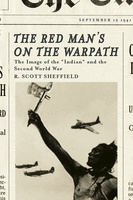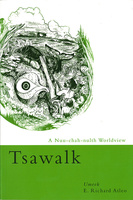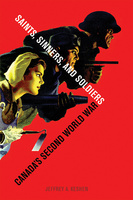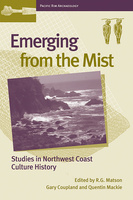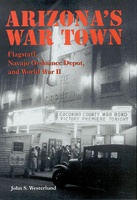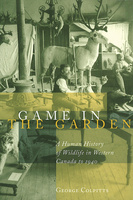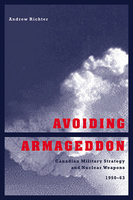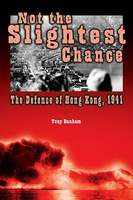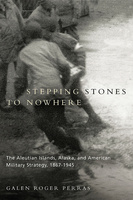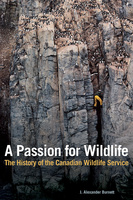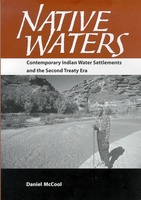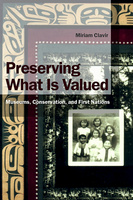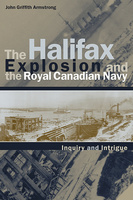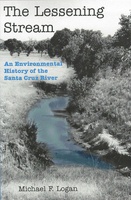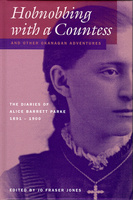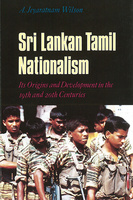The Red Man's on the Warpath
The Image of the "Indian" and the Second World War
This book explores how wartime symbolism and imagery propelled the “Indian problem” onto the national agenda, and why assimilation remained the goal of post-war Canadian Indian policy – even though the war required that it be rationalized in new ways.
“Real” Indians and Others
Mixed-Blood Urban Native Peoples and Indigenous Nationhood
A pioneering look at how mixed-blood urban Native people understand their identities and struggle to survive in a world that often fails to recognize them.
Paddling to Where I Stand
Agnes Alfred, Qwiqwasutinuxw Noblewoman
A first-hand account of the greatest period of change experienced by the Kwakwaka'wakw people since their first contact with Europeans.
Saints, Sinners, and Soldiers
Canada's Second World War
From labour conflicts to the black market to prostitution, this book examines the moral and social underbelly of Canada’s Second World War.
Canadians Behind Enemy Lines, 1939-1945
A history of the activities and lives of undercover Canadian operatives in Europe and Asia during World War II.
Negotiated Memory
Doukhobor Autobiographical Discourse
This demonstrates how the Doukhobors employed both “classic” and alternative forms of autobiography to communicate their views about communal living, vegetarianism, activism, and spiritual life, as well as to pass on traditions to successive generations.
Gutenberg in Shanghai
Chinese Print Capitalism, 1876-1937
Gutenberg in Shanghai demonstrates how Western technology and evolving traditional values resulted in the birth of a unique form of print capitalism whose influence on Chinese culture was far-reaching and irreversible.
The Cult of Happiness
Nianhua, Art, and History in Rural North China
The Cult of Happiness is among the first studies in any field to treat folk art and folk print as historical text. As such, this richly illustrated volume will appeal to a wide range of scholars in Asian studies, history, art history, folklore and print, as well as anyone having a passion for the creativity and culture of rural society.
A Voyage to the North West Side of America
The Journals of James Colnett, 1786-89
The journal of James Colnett is the last unpublished account of the early maritime fur trade on the Northwest Coast.
When Coal Was King
Ladysmith and the Coal-Mining Industry on Vancouver Island
The first scholarly history of the Ladysmith miners, the Great Strike of 1912-1914, and the coalmining industry on Vancouver Island.
Frigates and Foremasts
The North American Squadron in Nova Scotia Waters 1745-1815
A meticulously researched and groundbreaking study of the activities and motivations of the British Navy on North America’s eastern seabord.
The Oriental Question
Consolidating a White Man's Province, 1914-41
Patricia E. Roy continues her study into why British Columbians were historically so opposed to Asian immigration.
Hunters and Bureaucrats
Power, Knowledge, and Aboriginal-State Relations in the Southwest Yukon
A timely anthropological examination of the effect of land claims settlements and co-management of resources on the Kluane First Nation of the Southwest Yukon.
Emerging from the Mist
Studies in Northwest Coast Culture History
This book brings together the most recent research on the culture history and archaeology of a region of longstanding anthropological importance, whose complex societies represent the most prominent examples of hunters and gatherers.
Arizona's War Town
Few American towns went untouched by World War II, even those in remote corners of the country. During that era, the federal government forever changed the lives of many northern Arizona citizens with the construction of the U.S. Army ordnance depot at Bellemont, ten miles west of Flagstaff. John Westerlund now tells how this ...
Tales of Ghosts
First Nations Art in British Columbia, 1922-61
An insightful examination of the complex functions of Northwest Coast art objects produced between 1922 and 1961, and a vital addition to First Nations and Canadian history.
Parties Long Estranged
Canada and Australia in the Twentieth Century
A comparative collection of essays that examine different aspects of Canadian-Australian relations throughout the twentieth century.
Game in the Garden
A Human History of Wildlife in Western Canada to 1940
This intriguing book identifies the imaginative use of wild animals in early western society and shows how attitudes to wild animals changed according to subsistence and economic needs and how wildlife helped to determine social relations among people.
Avoiding Armageddon
Canadian Military Strategy and Nuclear Weapons, 1950-1963
An examination of Canadian military thinking on key issues of the nuclear age, such as deterrence, arms control, strategic stability, air defence, and the domestic acquisition of nuclear weapons.
Not the Slightest Chance
The Defence of Hong Kong, 1941
This book represents the first attempt to piece together all existing accounts of the December 1941 Battle of Hong Kong and the fighting between the Garrison and the invading Japanese.
A War of Patrols
Canadian Army Operations in Korea
Impeccably researched and analytical, this comprehensive account of the Canadian campaign in the Korean War provides the first detailed study of the training, leadership, operations, and tactics of the brigade under each of its three wartime commanders.
Stepping Stones to Nowhere
The Aleutian Islands, Alaska, and American Military Strategy, 1867-1945
Galen Perras shows how that changed with the Japanese occupation of the western Aleutians, which climaxed in the horrendous battle for Attu during the Second World War.
A Passion for Wildlife
The History of the Canadian Wildlife Service
A chronicle of the Canadian Wildlife Service and the evolution of wildlife policy over the first 50 years of this venerable Canadian institution's history.
Women and the White Man's God
Gender and Race in the Canadian Mission Field
Based on diaries, letters, and mission correspondence, this is the first comprehensive examination of women’s roles in Anglican missions that were active in northern British Columbia, Yukon, and the Northwest Territories between 1860 and 1940.
Modern Women Modernizing Men
The Changing Missions of Three Professional Women in Asia and Africa, 1902-69
Explores how professionalism, religion, and feminism came together to enable missionary women to become the colleagues and mentors of Western and non-Western men.
Making Native Space
Colonialism, Resistance, and Reserves in British Columbia
It presents the most comprehensive account available of perhaps the most critical mapping of space ever undertaken in BC – the drawing of the lines that separated the tiny plots of land reserved for Native people from the rest.
Native Waters
Since the beginning of the reservation era, the bitter conflict between Indians and non-Indians over water rights was largely confined to the courtroom. But in the 1980s the federal government began to emphasize negotiated settlements over lawsuits, and the settlements are changing water rights in fundamental waysnot only for tribes but also for non-Indian communities that share scarce water resources with Indians.
In Native Waters, Daniel McCool describes the dramatic impact these settlements are having both on Indian country and on the American West as a whole. Viewing the settlements as a second treaty era, he considers whether they will guarantee the water future of reservationsor, like treaties of old, will require tribes to surrender vast resources in order to retain a small part of their traditional homelands. As one tribal official observed, "It's like your neighbors have been stealing your horses for many years, and now we have to sit down and decide how many of those horses they get to keep." Unlike technical studies of water policy, McCool's book is a readable account that shows us real people attempting to end real disputes that have been going on for decades. He discusses specific water settlements using a combination of approachesfrom personal testimony to traditional social science methodologyto capture the richness, complexity, and human texture of the water rights conflict. By explaining the processes and outcomes in plain language and grounding his presentation in relevant explanations of Indian culture, he conveys the complexity of the settlements for readers from a wide range of disciplines.
Native Waters illustrates how America is coming to grips with an issue that has long been characterized by injustice and conflict, seeking to enhance our understanding of the settlements in the hope that this understanding will lead to better settlements for all parties. As one of the first assessments of a policy that will have a pervasive impact for centuries to come, it shows that how we resolve Indian water claims tells us a great deal about who we are as a nation and how we confront difficult issues involving race, culture, and the environment.
Preserving What Is Valued
Museums, Conservation, and First Nations
What are the “right ways” to preserve heritage? Are the aims and purposes of museums necessarily at odds with those of First Nations? This thoughtful book explores the concept of museum conservation in light of cultural repatriation issues, and helps readers understand the complex relationship between museums and Aboriginal peoples.
A Trading Nation
Canadian Trade Policy from Colonialism to Globalization
This brilliantly crafted overview and analysis of the historical foundations of modern Canadian trade policy is the first survey to address the history of Canadian commercial policy in over fifty years.
The Indian Association of Alberta
A History of Political Action
Best known for its role in spearheading the protest against the infamous 1969 White Paper produced by the Department of Indian Affairs, the Indian Association of Alberta played a critical role in mobilizing First Nations peoples to political action.
The Lessening Stream
Newcomers to Tucson know the Santa Cruz River as a dry bed that can become a rampaging flood after heavy rains. Yet until the late nineteenth century, the Santa Cruz was an active watercourse that served the region's agricultural needsuntil a burgeoning industrial society began to tap the river's underground flow.
The Lessening Stream reviews the changing human use of the Santa Cruz River and its aquifer from the earliest human presence in the valley to today. Michael Logan examines the social, cultural, and political history of the Santa Cruz Valley while interpreting the implications of various cultures' impacts on the river and speculating about the future of water in the region.
Logan traces river history through three erasarchaic, modern, and postmodernto capture the human history of the river from early Native American farmers through Spanish missionaries to Anglo settlers. He shows how humans first diverted its surface flow, then learned to pump its aquifer, and today fail to fully understand the river's place in the urban environment.
By telling the story of the meandering riverfrom its origin in southern Arizona through Mexico and the Tucson Basin to its terminus in farmland near PhoenixLogan links developments throughout the river valley so that a more complete picture of the river's history emerges. He also contemplates the future of the Santa Cruz by confronting the serious problems posed by groundwater pumping in Tucson and addressing the effects of the Central Arizona Project on the river valley.
Skillfully interweaving history with hydrology, geology, archaeology, and anthropology, The Lessening Stream makes an important contribution to the environmental history of southern Arizona. It reminds us that, because water will always be the focus for human activity in the desert, we desperately need a more complete understanding of its place in our lives.
Hobnobbing with a Countess and Other Okanagan Adventures
The Diaries of Alice Barrett Parke, 1891-1900
In 1891, Alice Barrett moved from Port Dover, Ontario, to the Okanagan Valley. Few women’s diaries have survived from that time, and Barrett Parke recalls a period of profound transformation in a region newly opened to white settlement.
Place, Culture and Identity
Essays in Historical Geography in Honour of Alan R.H. Baker
This book features twelve commissioned essays recognizing Alan R.H. Baker, a leading scholar in historical geographyhighly influential and innovative contributions.
Scars of War
The Impact of Warfare on Modern China
A forceful look at the long-term social and psychological impact of warfare on modern China’s civilian population.
In/visible Sight
The Mixed-Descent Families of Southern New Zealand
Drawing on the experiences of mixed-Maori/White families, Wanhalla examines the early history of southern New Zealand, a world in which inter-racial intimacy played a formative role.
Early Childhood Care and Education in Canada
Past, Present, and Future
Larry Prochner and Nina Howe reflect the variation within the field by bringing together a multidisciplinary group of experts to address key issues in the field.
Cis dideen kat – When the Plumes Rise
The Way of the Lake Babine Nation
This book, the first to be written about the Lake Babine Nation in north-central British Columbia, examines its traditional legal order, self-identity, and their involvement in current treaty negotiations.
The Chinese in Vancouver, 1945-80
The Pursuit of Identity and Power
Wing Chung Ng captures the fascinating story of the city's Chinese in their search for identity.
Religion in the Modern American West
When Americans migrated west, they carried with them not only their hopes for better lives but their religious traditions as well. Yet the importance of religion in the forging of a western identity has seldom been examined. In this first historical overview of religion in the modern American West, Ferenc Szasz shows the important role that organized religion played in the shaping of the region from the late-nineteenth to late-twentieth century. He traces the major faiths over that time span, analyzes the distinctive response of western religious institutions to national events, and shows how western cities became homes to a variety of organized faiths that cast only faint shadows back east. While many historians have minimized the importance of religion for the region, Szasz maintains that it lies at the very heart of the western experience. From the 1890s to the 1920s, churches and synagogues created institutions such as schools and hospitals that shaped their local communities; during the Great Depression, the Latter-day Saints introduced their innovative social welfare system; and in later years, Pentecostal groups carried their traditions to the Pacific coast and Southern Baptists (among others) set out in earnest to evangelize the Far West. Beginning in the 1960s, the arrival of Asian faiths, the revitalization of evangelical Protestantism, the ferment of post-Vatican II Catholicism, the rediscovery of Native American spirituality, and the emergence of New Age sects combined to make western cities such as Los Angeles and San Francisco among the most religiously pluralistic in the world. Examining the careers of key figures in western religion, from Rabbi William Friedman to Reverend Robert H. Schuller, Szasz balances specific and general trends to weave the story of religion into a wider social and cultural context. Religion in the Modern American West calls attention to an often overlooked facet of regional history and broadens our understanding of the American experience.
Reclaiming Indigenous Voice and Vision
This inspiring volume elaborates a new inclusive vision of a global and national order and articulates new approaches for protecting, healing, and restoring long-oppressed peoples, and for respecting their cultures and languages.
Potlatch at Gitsegukla
William Beynon's 1945 Field Notebooks
This rare, first-hand, ethnographic account of a potlatch from Tsimshian scholar William Benyon reveals the wonderful complexities of the events that took place in Gitsegukla in 1945.
Islands of Truth
The Imperial Fashioning of Vancouver Island
Timely, provocative, and a vital contribution to post-colonial studies, this book questions premises underlying much of present B.C. historical writing, arguing that international literature offers more fruitful ways of framing local historical experiences.
Telling Tales
Essays in Western Women's History
Telling Tales both challenges founding myths of the region and inspires rethinking of how we tell the story of western Canadian colonization and settlement.
The Chaco Mission Frontier
Spanish missions in the New World usually pacified sedentary peoples accustomed to the agricultural mode of mission life, prompting many scholars to generalize about mission history. James Saeger now reconsiders the effectiveness of the missions by examining how Guaycuruan peoples of South America's Gran Chaco adapted to them during ...
The Canadian Department of Justice and the Completion of Confederation 1867-78
Drawing on legal records and other archival documents, Jonathan Swainger considers the growth and development of the ostensibly apolitical Department of Justice in the eleven years after the union of 1867.
The Frontier World of Edgar Dewdney
The Frontier World of Edgar Dewdney is a biography of a man who played a key role in the events which marked the political, social, and economic transformation of western Canada in the latter half of the nineteenth century.
Sri Lankan Tamil Nationalism
This book offers a concise history of the Sri Lankan Tamil nation, examining its culture and political evolution.

